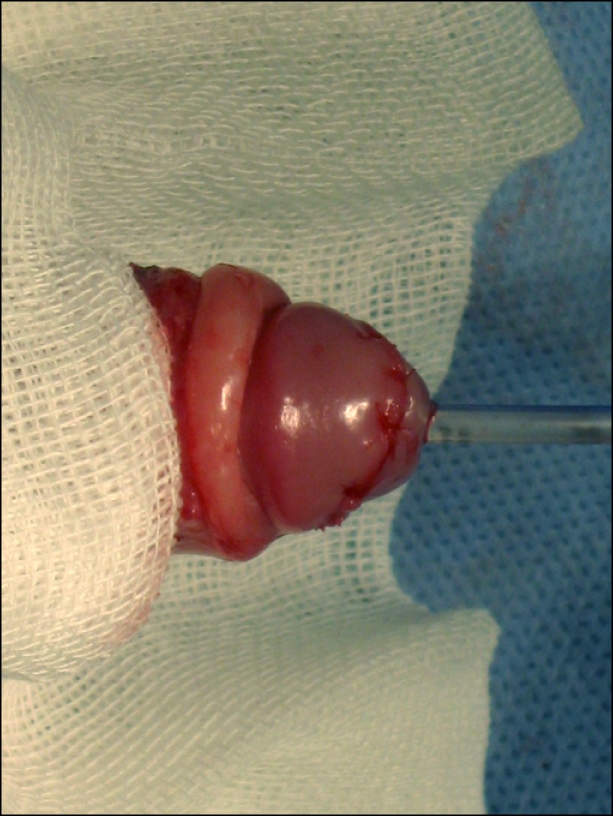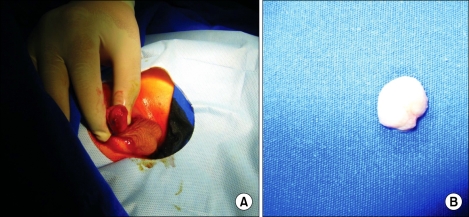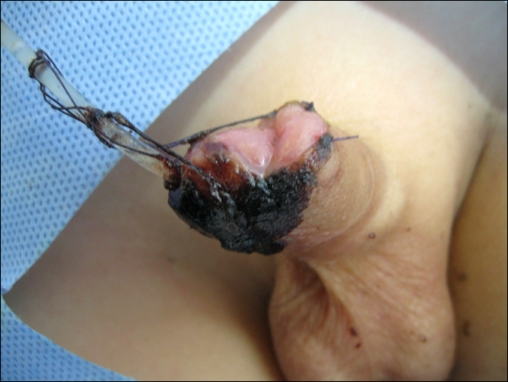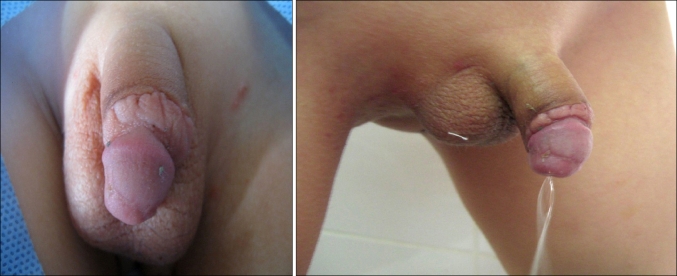Abstract
Penile amputation is an uncommon condition that requires immediate surgical replantation. Routine standardized procedures for dealing with this medical condition do not exist. We describe a case of complete guillotine-type glans penis amputation and review the relevant literature. We performed urethral end-to-end approximation and glanular anastomosis and then applied hyperbaric oxygen therapy postoperatively. We obtained very good cosmetic and functional results.
Keywords: Amputation, Circumcision, Penis
Circumcision has a rare but definitive risk of complications, such as penile amputation, penile denudation, and buried penis [1,2]. We report a rare circumcision complication, glans penis amputation, and its management by use of a primary reattachment technique and hyperbaric oxygen (HBO) therapy.
CASE REPORT
A 7-year-old boy was admitted to the hospital with a guillotine-type pyramidal amputation of the distal one-third of the glans penis distal to the corona of the glans penis (Fig. 1). The prepuce was also excised completely. The circumcision had been done in an outpatient clinic by a person who was neither a urologist nor a surgeon and who had inadvertently caught the glans in the clamp, which resulted in glans penis amputation. The glans penis had been stored in sterile saline solution until reaching our hospital after 1 hour, and the reconstruction was performed within 2 hours of the amputation.
FIG. 1.
(A) Guillotine type penile amputation. (B) Amputated part of the glans penis.
The cut surfaces were cleaned with sterile saline and swabbed with povidone-iodine. The urethra was stented with an 8 Fr urethral catheter from the external urethral meatus through the proximal urethra. It was hard to see the proximal part of the intact urethral mucosa to dissect and make anastomotic sutures in the glans penis. Therefore, we just approximated the separated parts of the urethral mucosal surfaces over a urethral catheter. Then the amputated part of the glans penis and the proximal glans penis were anastomosed with intermittent 4/0 Vicryl. The proximal penile skin and mucosa of the glans penis were approximated with intermittent 4/0 Vicryl to complete the circumcision (Fig. 2). No tourniquet was applied to the radix penis during the operation for bleeding control. The glans was pale pink in the first day after the operation. In our opinion, this was an early sign of blood perfusion of the glans penis. Care was taken postoperatively to immobilize the anastomosis. We did not need to place a cystostomy catheter.
FIG. 2.
Appearance of the penis and urethral stent postoperatively.
On the second postoperative day, edema and some eggplant discoloration were seen at the distal part of the anastomosis. Because of this insufficient oxygenation of tissue, HBO therapy was started immediately and was continued until the 20th postoperative day. We gave cefuroxime axetil 500 mg tb during the postoperative period for 10 days. On the 7th postoperative day, partial necrosis developed over the glans penis near the frenulum (Fig. 3). On the 12th day the necrotic crust was debrided superficially and on the 14th day the urethral stent was removed. The glans gained vitality progressively and had healed completely by week 4. The patient voided with a good stream (Fig. 4). No urethral fistula or stricture developed at the anastomotic site. After 2 months, there was no meatal stenosis, voiding was normal, and the cosmetic and functional results were still excellent.
FIG. 3.
Partial superficial necrosis of the penis on the 7th postoperative day.
FIG. 4.

Appearance of the penis at the end of hyperbaric oxygen therapy on the 30th postoperative day.
DISCUSSION
Complications are unavoidable during circumcision performed owing to religious beliefs under poor surgical conditions in Islamic countries. The complication rate for newborn circumcision is 0.2% to 3% [3]. Bleeding and wound infection are the most frequently reported minor complications. Penile adhesions and removal of too much or too little skin are other complications that can occur [4]. The most serious circumcision complications are urethral injury and removal of part of the glans or part or all of the penile shaft [1,5]. There are several penile amputation reports but only a few glans amputation reports in the literature. Partial glans removal has been reported to occur with the use of clamp techniques. In the circumcision technique widely used in Turkey, the foreskin is pulled and clamped just distal to the tip of the glans and is excised between the glans and the clamp. The operator then sutures the distal cut edge of the penile skin and the mucosal cut edge of the inner prepuce. With this technique, amputation can occur if the operator inadvertently catches the glans in the clamp, as in our case.
The level of amputation is very critical in managing penile amputation. If the amputation occurs at the shaft of the penis, microvascular replantation is recommended [6]; however, there are some case reports of successful replantation of a completely amputated penis by use of a macrosurgical technique [7]. If partial glans amputation occurs, the excised tissue should be preserved and immediately sutured back to the penis [4] and microscopic repair is unnecessary. When repair is performed within 8 hours after the injury, the penis heals nicely in most cases [4]. We reconstructed the amputated glans by means of macroscopic surgery because it was not possible to dissect the vascular structures for microsurgical anastomosis. It is preferable to replant distal glanular amputations as a composite graft, as in our case [1].
Anastomotic urethroplasty generally is inappropriate in the glans penis because excision and spatulated reanastomosis of even the shortest penile urethra will incur at least 1 cm of urethral shortening, which is sufficient to cause ventral chordee [8]. We aimed to achieve a maximal cosmetic result with minimal tissue loss initially. Instead of urethral shortening, we accepted the risk of urethral stricture or fistula development and management of these problems. The goal of our technique was to position the amputated part of the glans on the proximal part of the glans over a urethral catheter and to try to keep the graft immobilized with dressings. This regenerative procedure relies on reepithelialization of the urethra once the lumen has been restored. This technique tends to be the most successful with little spongiofibrosis, where reepithelialization can occur on a virgin bed [8].
Shin reported a microvascular anastomosis of penile shaft after penile amputation that led to tissue necrosis after the operation and eventual penoplasty [9]. Oxygen plays an important role in the physiology of wound healing. HBO can raise tissue oxygen tensions to levels at which the wound can be expected to heal. HBO therapy is a treatment in which a patient breathes 100% oxygen in a pressurized environment of at least 1.4 atmospheres. Compromised skin grafts and flaps can be treated by HBO. HBO therapy also increases angioneogenesis and stimulates fibroblast proliferation [10]. We used HBO therapy in the present case to increase circulation and oxygen levels in order to obtain better wound healing.
In summary, multiple complications can occur after circumcision, ranging from the insignificant to the tragic. Virtually all of these complications are preventable with only a modicum of care. Unfortunately, most such complications occur at the hands of inexperienced operators who are neither urologists nor surgeons.
Although it is not possible to arrive at a conclusion from only one case, this penile reattachment technique seemed successful. We attribute the successful healing to passive blood diffusion from the proximal penis to the amputated glans and angioneogenesis and the wound healing effects of HBO therapy.
Footnotes
The authors have nothing to disclose.
References
- 1.Gluckman GR, Stoller ML, Jacobs MM, Kogan BA. Newborn penile glans amputation during circumcision and successful reattachment. J Urol. 1995;153:778–779. [PubMed] [Google Scholar]
- 2.van der Zee JA, Hage JJ, Groen JM, Bouman FG. A serious complication of ritual circumcision of a 'buried' penis. Ned Tijdschr Geneeskd. 1991;135:1604–1606. [PubMed] [Google Scholar]
- 3.Ben Chaim J, Livne PM, Binyamini J, Hardak B, Ben-Meir D, Mor Y. Complications of circumcision in Israel: a one year multicenter survey. Isr Med Assoc J. 2005;7:368–370. [PubMed] [Google Scholar]
- 4.Elder JS. Abnormalities of the genitalia in boys and their surgical management. In: Wein AJ, Kavoussi LR, Novick AC, editors. Campbell-Walsh urology. 9th ed. Philadelphia: Saunders; 2007. pp. 3745–3760. [Google Scholar]
- 5.Yilmaz AF, Sarikaya S, Yildiz S, Büyükalpelli R. Rare complication of circumcision: penile amputation and reattachment. Eur Urol. 1993;23:423–424. doi: 10.1159/000474644. [DOI] [PubMed] [Google Scholar]
- 6.Kayikcioglu A, Ozcan G. Partial necrosis of an amputated penis following replantation in a heavy smoker: a case report. Microsurgery. 1998;18:189–191. doi: 10.1002/(sici)1098-2752(1998)18:3<189::aid-micr12>3.0.co;2-u. [DOI] [PubMed] [Google Scholar]
- 7.Shin HS, La YH, Park SS. Microsurgical reimplantation of a completely amputated penis in a child. Korean J Urol. 1989;30:456–459. [Google Scholar]
- 8.Webster GD, Venn SN. Strictures of the male urethra. In: Gillenwater JY, Howards SS, Grayhack JT, editors. Gillenwater adult and pediatric urology. 4th ed. Philadelphia: Lippincott Williams & Wilkins; 2002. p. 1773. [Google Scholar]
- 9.Lee SY, Yang CS, Myung SC. Replantation of a completely amputated penis, which occurred in a child during circumcision. Korean J Urol. 2005;46:1360–1362. [Google Scholar]
- 10.Çek D, Sözübir S, Güvenç BH, Elbüken ME. A rare complication of circumcision: coronal penile amputation successfully treated by replantation and hyperbaric oxygen therapy. Eur J Plast Surg. 2001;24:307–309. [Google Scholar]





